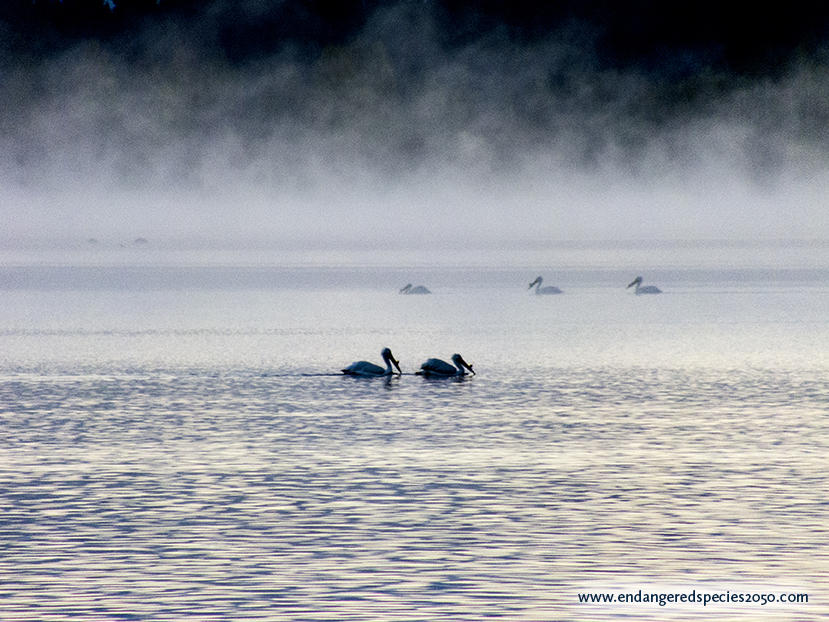

The American White Pelican is endangered in British Columbia Canada and is threatened in Ontario Canada.


Endangered American White Pelicans in the Morning Mist of Quesnel BC. Photo: Carmen Traub

Though these birds mate in different parts of British Columbia, there is only one nesting colony of American White Pelicans. It is located at Stum Lake in White Pelican Provincial Park in the Chilcotin region, 70 kilometres west of Williams Lake.
Because these colonial birds are migratory, have only a single nesting site, and feed on fish in shallow lakes sometimes hundreds of kilometres from Stum Lake, they are particularly vulnerable to a variety of threats. At Stum Lake, both natural and human-influenced events can affect nesting success. Fluctuating water levels are the most frequent natural cause of colony abandonment. In drought years, nesting islands become connected to the mainland, allowing access to land-based predators. A single severe flood or a series of wet years can result in inundation of islands. Over the thousands of years they have existed on this continent, white pelicans have been able to cope with these natural events and maintain their overall population. In recent decades, however, various drainage, irrigation, and diversion projects, particularly in the United States, have resulted in the demise of some colonies.
Steps have been taken to protect the nesting grounds at Stum Lake. Stum Lake, within White Pelican Provincial Park, is closed to the public from March 1 – August 31 every year to protect the White Pelican nesting colony. Canoeing, boating, hunting, trapping, discharge of firearms, aircraft operation below 600 metres in elevation, and aircraft landing are prohibited on Stum Lake (located within the park) from March 1st to August 31st every year due to the American White Pelican nesting there. They are very sensitive to disturbance; disturbances can result in the loss of all young. Pelican viewing opportunities exist at Nazko Lake Park and in other lakes in the Chilcotin.
In the Canadian province of Ontario, another important stop for the American White Pelican, this bird has been designated to the threatened list in that region. “Threatened”, meaning, the species lives in the wild in Ontario, is not endangered, but is likely to become endangered if steps are not taken to address factors threatening it. The pelican was an endangered species in Ontario from 1977 to 2009, but was ‘upgraded’ to threatened in 2009. The Ministry of Natural Resources and Forestry has developed a an American White Pelican Recovery Strategy. A recovery strategy provides the best available scientific knowledge on what is required to achieve recovery of a species. A recovery strategy outlines the habitat needs and the threats to the survival and recovery of the species. It also makes recommendations on the objectives for protection and recovery, the approaches to achieve those objectives, and the area that should be considered in the development of a habitat regulation. Recovery strategies are required to be prepared for endangered and threatened species within one or two years respectively of the species being added to the Species at Risk in Ontario list. There is a transition period of five years to develop recovery strategies for those species listed as endangered or threatened. Recovery strategies are required to be prepared for extirpated species only if reintroduction is considered feasible.
In Ontario, the pelicans nest primarily on two lakes in the northwest — Lake of the Woods and Lake Nipigon. But the birds can fly hundreds of kilometres away to get food. In the past, fisherman in the Ontario aread had been complaining that the birds are competing with them for fish and are therefore an invasive species . But the truth is that pelican’s don’t consume sports fish. Since Pelican are often viewed by sports fisherman as a possible competition for sport fish there’s a history of harassment and persecution of pelicans because of that. However, pelicans are not a threat to a sports fishing since they eat different fish in the lakes. Pelicans are not depleting lakes of sports fish. They are indeed helping with the ecosystem, as they consume other invasive creatures that could take over lakes and fisheries. The Ontario Government does not agree with abuse of their threatened American White Pelicans, and The Ministry of Natural Resources can lay charges for disturbing or destroying habitat within 300 meters of a pelican nesting colony.[/text_block]

An early morning hunt for fish ensues in the misty fog of a pristine lake in Quesnel, B.C.
[/text_block]

[/text_block]
